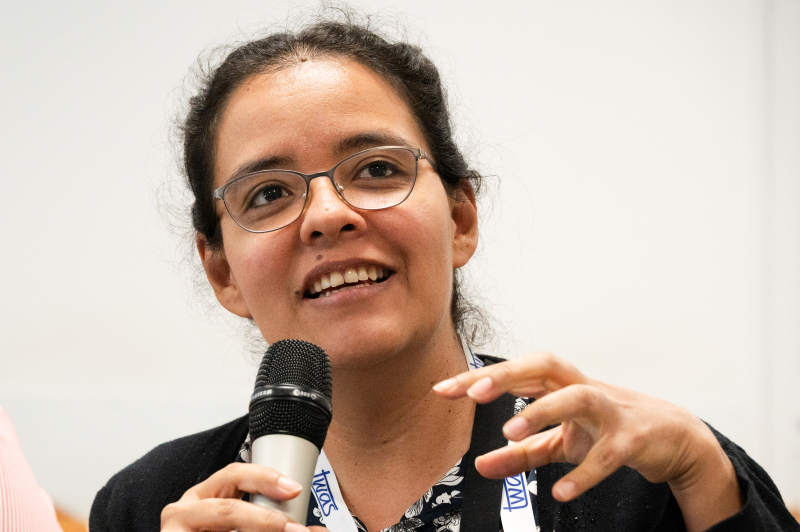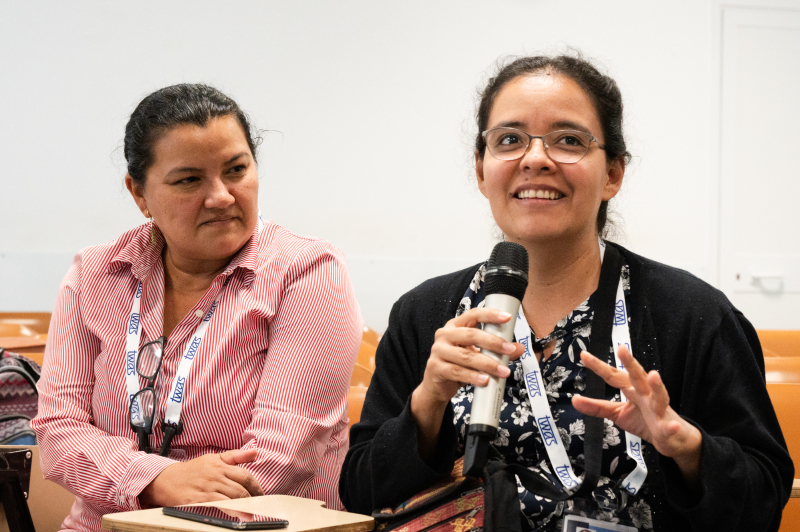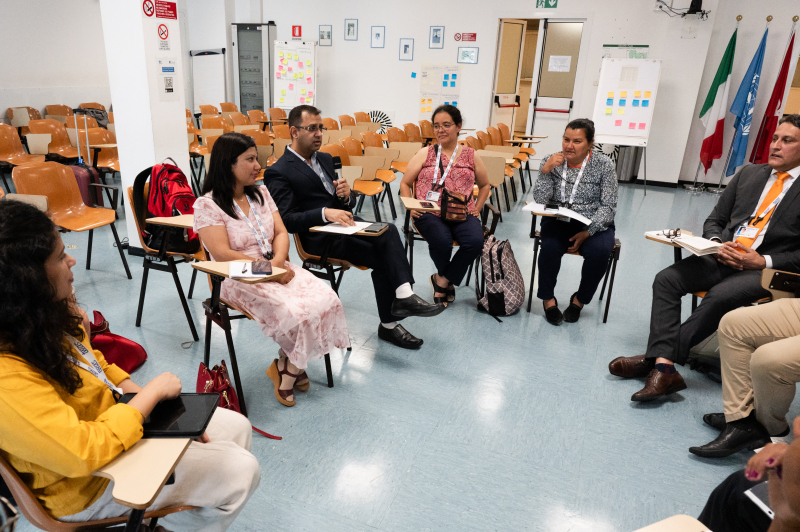María Eugenia Cabrera Catalán is a Guatemalan physicist, and this year she attended a science diplomacy course for the first time in her life. As a physicist, her concept of what science diplomacy was, as well as how it could be useful, was quite vague.
However, through participating in the 11th AAAS-TWAS Course on Science Diplomacy, held in Trieste, Italy, from June 18-20, she realized that group discussions and simulated scenarios offer practical opportunities to challenge new skills.

This is also what the 20 early career scientists and policymakers from 11 developing countries, including Cameroon, Guatemala, Nepal, and Sudan, experienced during the event. They worked in pairs, simulating realistic situations that required a diplomatic approach because of their transboundary implications.
The course was funded by the Swedish International Development Cooperation Agency (Sida) and AAAS. The Organization for Women in Science for the Developing World (OWSD), whose secretariat is hosted by TWAS in Trieste, also contributed funding for this edition.
Cabrera Catalán is a professor with the School of Physical Sciences and Mathematics and a member of the Institute of Physical Sciences and Mathematics at the University of San Carlos of Guatemala. She was paired with Victoria Lorena Moraga Conde, a PhD candidate in Government and Public Policy at the University of Costa Rica (UCR).

They were assigned to the group tackling the issue of a transboundary forest where poachers were a danger to rare species. In that simulation, Cabrera Catalán and Moraga Conde represented spokespersons from a Regional Development Bank, playing the science advisor and the head of the loans department respectively.
In the following interview, edited for clarity, Cabrera Catalán highlights what are the most important insights that she gained from the event.
Q. How come a theoretical physicist like you decided to attend a science diplomacy course?
A. There are two reasons behind it. I applied thanks to a former science diplomacy participant, Encieh Erfani, a cosmologist from Iran, who attended it and shared her enthusiasm via social media. That feeling was contagious, and I thought that I could also participate, to learn about science diplomacy and widen my mind by exploring new horizons.
Q. And the second one...?
A. In 2006 I attended a diploma programme at ICTP, and knowing colleagues from developing countries was a great experience. But what really inspired me was reading Abdus Salam's speech when he got his Nobel prize. In essence, he said that we should bring science everywhere for the benefit of all mankind.*
Q. How important was your European experience?
A. It was very important, I learned how cutting-edge knowledge is built as a collective effort. Upon my return to Guatemala, after an experience in Madrid where I did my PhD, and in Amsterdam and São Paulo as a postdoctoral researcher, I probably had the wrong approach. I wanted to replicate what I had seen in developed countries. I was not fully aware that Guatemala has not the same infrastructures, and that things would not work here the same way they do in Europe.

Q. You came to the course with no previous experience in science diplomacy. How are you going to leave?
A. I have certainly acquired a more humble approach to situations. Before coming here, I thought that diplomats, policy makers, and people from the governments should be aware of the importance of science and consult the scientists, because we, the scientists, understand the evidence and models that describe the phenomena of nature. But now my perspective has changed. I understand that we, the scientists, should value everybody in the same way, and make some steps towards other parties to give equal value to all the opinions and roles. This is the only way in which things can change for a common benefit.
Q. With your colleague Moraga Conde, you participated in the group discussing the challenges posed by poachers in a transboundary forest. What was the essence of your role, and your contribution to the discussion?
A. We played the head of the Department of Loans and the science advisor of the Regional Development Bank. We secured US$500 million dollars from the members, for the bank to address wildlife trafficking in the region. Countries would receive the loan only if they proposed a plan to stop illegal wildlife trade as a part of a project that guarantees sustainably managed forests, reversing land degradation and halting biodiversity loss. During the discussion we kept on motivating all the countries to reach an agreement that satisfies CITES, the global treaty that regulates the trade of wild animals and plants across borders. The countries wanted to receive the money, therefore we kept reminding them that if they succeeded in solving the problem of illegal wildlife, that would be a win-win result for all.
Q. As a physicist, how will you use the skills that you learned in this course?
A. I realized that I still have much to learn about effective communication. There are quite a few good physicists here and in neighbouring countries. The problem is that we are all isolated, we tend not to collaborate among us. This is indeed the major take-home message for me: the need for planning and working together. My first steps will be sharing with colleagues what I have learned, to try to raise awareness about the importance of science diplomacy. In addition, I would like to implement cooperation within my national scientific networks to stimulate discussion about how we, as scientists, could establish a communication channel with decision makers.
Q. How does it feel being a female physicist in a developing country like Guatemala? What are the challenges?
A. I have different experiences at different stages of my career. In the beginning, when I was the only woman in Guatemala with a PhD in physics, people looked at me in a suspicious way. In the following years, things changed. Young students began perceiving me as a role model, which put a lot of pressure on me. I felt great responsibility because young high school students approached me asking "How did you become a physicist"? Also, some people did not feel very comfortable with my role as a woman scientist. Now we are two women with a PhD in my faculty in Guatemala, both physicists, and I feel more relaxed.
Q. You are the winner of the 2021 OWSD-Elsevier Foundation Award in physical sciences. Was this achievement important for your career?
A. When I received this prize, my image skyrocketed. Then, colleagues from Mexico, Panama, and also Brazil started inviting me as a speaker, in public events. This was a huge impact, I realized that I was becoming a national and international reference point.
Watch a video from the AAAS-TWAS Course on Science Diplomacy here.
Q. You have also been elected a 2023 TWAS Young Affiliate: what does this affiliation mean to you?
A. TWAS affiliation is very important, especially because, in Guatemala we are pretty isolated. Through TWAS and the TYAN network I have the feeling that I am part of a wider group of young researchers from all over the world, who are trying to make a difference with their research and efforts. I tended to be very hard on myself, but thanks to this affiliation I am becoming more indulgent. I got accepted by TWAS: this means something.
Q. What are your plans for the future?
A. Along with some physicists from Honduras and Costa Rica we are trying to formalize a work group in Central America, a collaborating team. We are a small network, now, but we want to move forward promoting higher physics and scientific computing. Some of these colleagues are members of CERN: we want to show students and society that we can build a competitive and skilled group.
It's just a matter of finding our own style. I'd call it the Central American way of doing physics.
Cristina Serra
* Abdus Salam's words were: "Let us strive to provide equal opportunities to all so that they can engage in the creation of Physics and science for the benefit of all mankind."
More photos from the event are available at the TWAS Flickr Page.

